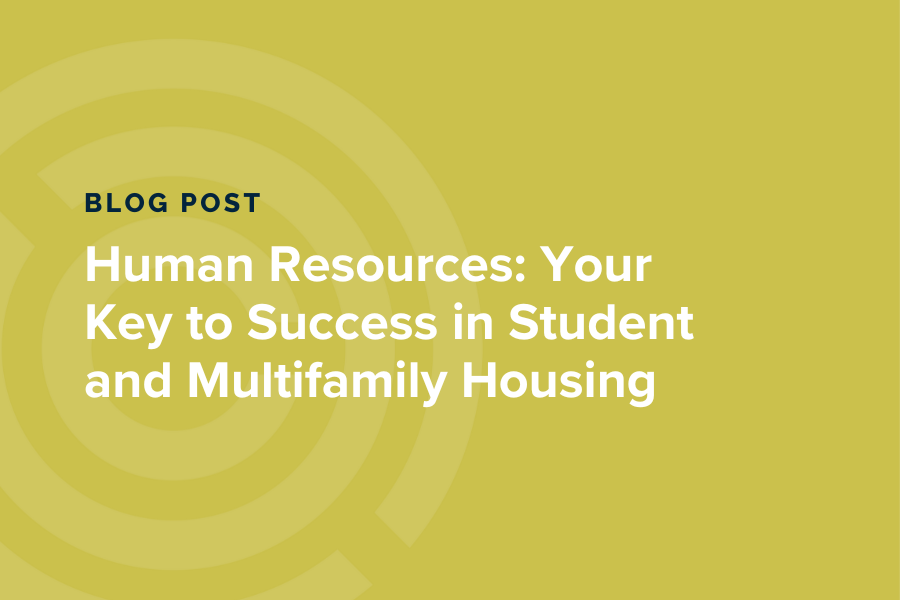Across industries, human resources (HR) has more universal similarities than significant differences. The core, shared tenets of HR are far-reaching, from legal and compliance to ethics, equitable practices, and employee support. Beyond the foundational elements, many teams and professionals instead use the term “people operations” to focus on serving a key strategic role in the organization and concentrate on strategy, outcomes, and performance.
But in multifamily and student housing, there are some nuances and unique challenges to HR that are critical to understand and focus on. HR in housing requires working within a varied set of expectations, needs, and numerous categories of stakeholders, from owners to asset managers, residents, and employees. When these differences are acknowledged and factored in, the role of HR can be even more valuable and important to a housing provider.
This article touches on three key areas: understanding the differences that make HR in residential housing unique, exploring why and how HR can spur innovation and collaboration, and ensuring this key function supports business objectives.
Understanding the Residential Differences
Residential housing management has a multitude of unique elements, such as employees who live where they work (raising issues of compensation and the importance of work-life harmony), the exclusive nature of the customer lease and lifecycle, and changing employee trends that affect hiring and retention of extraordinary talent. The talent market and employee lifecycle are also unique in this industry, creating relocation challenges for markets low on talent, and making retention even more critical in competitive, talent-heavy markets.
Student vs. Multifamily
There are notable differences that warrant careful consideration and strategy between student and multifamily housing. The employee demographic in student housing tends to be earlier in their careers and less experienced, but eager to learn to advance in their role. This can create training challenges and talent pipeline opportunities. Turnover might be higher due to the seasonal nature of the industry, including the churn of student staff graduating. There is also a unique calendar with 12-month leases that terminate at or around the same time each year, creating a different hiring and employee work cycle.
Innovating and Implementing Best Practices
HR professionals in student and multifamily housing must adopt a multifaceted approach that understands the unique needs and challenges of their employee demographic, considers the customer lifecycle, and grasps the trends, n eeds, and interests of the business.
This level of understanding allows HR to contribute to overall business goals, fostering a culture that values customer service and community engagement.
Understanding both the HR and industry landscapes is important for any HR professional, and this understanding is even more important in residential housing management. Any HR professional working in a multifamily or student housing environment would be well-served to spend time on site, so they can understand the day-to-day operations and speak with their site team members at every level.
Fostering Innovation and Collaboration
HR can and should be central to creating a culture of innovation and collaboration because success starts with open communication and relationship-building. Not only do these elements aid in building trust with team members, they also support a natural flow of discussion during key problem-solving conversations and day-to-day interactions such as staff meetings and 1:1s. As leaders, we want to ensure our team feels seen and heard when they bring their contributions to the floor; otherwise, this can lead to moments of doubt and uncertainty in their role within the organization.
Strategies such as cross-functional teams, idea-sharing platforms, and regular brainstorming sessions can help cultivate an environment where creativity thrives.
Innovation + Change Management = Success
Innovation must be done well to yield desired results. Two core tenets of Centricity are innovation and change management — combined, they create a supportive foundation for growth and success. When properly leveraged and implemented, the combination of innovation with good change management yields desired outcomes. The innovative advances we provide for our clients are a fundamental change in the way things are done. This innovation (and therefore change) can and must be implemented with strategy and intention.
Aligning HR Initiatives with Business Objectives
At the end of the day, the desired outcomes and objectives of the business should inform and drive every aspect of the operation, including HR. To put the pieces of understanding and innovation together in a way that yields results, a clear focus must be placed on the business objectives.
From pay to promotions to PTO, how a company manages their people will make or break the business.
Your HR team needs to understand the unique ways they need to serve and have a keen awareness of your organization’s goals. How are you making this connection between your most important element — your people — and your most important business goals and outcomes?
If HR does not have an ongoing seat at the table with senior and executive leadership when it comes to important business strategy and planning, we encourage you to create intentional points of connection, so you are not missing out on the power of your people operations and connecting that power to your most important business objectives. At Centricity, we make sure this alignment happens. We work with our clients to continuously understand your business goals and strategies as they evolve. Combine this with our underpinning of innovation and the industry understanding we bring, and you have a solution that reduces stress, increases strength and stability, and saves money. Please reach out today to set up a free consultation and assessment of how Centricity can serve you.
